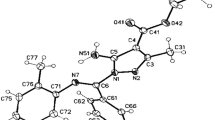Abstract
A novel tandem reductive amination/intermolecular nucleophilic aromatic substitution (SNAr) sequence has been established for the synthesis of amine containing pyrimidine in formation of one carbon-oxygen and one carbon-nitrogen bonds in a one-pot fashion. Treatment of aldehyde with arylamine, 2-methanesulfonyl-4,6-dimethoxypyrimidine and sodium borohydride provides good overall yield. The p-toluenesulfonic acid (PTSA) can be used as activator and is generally needed in the reaction. Dioxane is the preferred reaction solvent, but reactions can also be carried out in tetrahydrofuran (THF), MeCN, toluene and dichloromethane. The procedure is carried out effectively in the presence of K2CO3. The reaction proceeds smoothly with aromatic aldehydes and arylamines possessing electron-donating or -withdrawing groups. This method can be applied to the synthesis of the oilseed rape herbicide and is superior to the classical one in several aspects: cutting out several purification steps, minimizing solvent use and chemical waste, and saving time. Its advantages such as operational convenience, high-efficient synthesis, and starting material availability make it a desirable method for preparing amines with molecular diversity and biological activity.
Similar content being viewed by others
References
Abdel-Magid, A.F., Mehrman, S.J., 2006. A review on the use of sodium triacetoxyborohydride in the reductive amination of ketones and aldehydes. Org. Process Res. Dev., 10(5):971–1031. [doi:10.1021/op0601013]
Abdel-Magid, A.F., Carson, K.G., Harris, B.D., Maryanoff, C.A., Shah, R.D., 1996. Reductive amination of aldehydes and ketones with sodium triacetoxyborohydride. studies on direct and indirect reductive amination procedures. J. Org. Chem., 61(11):3849–3862. [doi:10.1021/jo960057x]
Beshore, D.C., Dinsmore, C.J., 2002. Preparation of substituted piperazinones via tandem reductive amination-(N,N′-acyl transfer)-cyclization. Org. Lett., 4(7):1201–1204. [doi:10.1021/ol025644l]
Bunce, R.A., Nago, T., White, B., 2008. 6-nitro-1,2,3,4-tetrahydroquinolines by a tandem reductive amination-SNAr reaction. J. Heterocyclic Chem., 45(4):1155–1160. [doi:10.1002/jhet.5570450433]
Bunce, R.A., Nago, T., White, B., 2009. (±)-1,2-dialkyl-5-nitro-2,3-dihydro-1H-indoles by a tandem reductive amination-SNAr reaction. J. Heterocyclic Chem., 46(4): 629–634. [doi:10.1002/jhet.82]
Cho, B.T., Kang, S.K., 2005. Direct and indirect reductive amination of aldehydes and ketones with solid acid-activated sodium borohydride under solvent-free conditions. Tetrahedron, 61(24):5725–5734. [doi:10.1016/j.tet.2005.04.039]
Dinsmore, C.J., Zartman, C.B., 2000. Efficient synthesis of substituted piperazinones via tandem reductive amination-cyclization. Tetrahedron Lett., 41(33):6309–6312. [doi:10.1016/S0040-4039(00)01063-7]
Gomez, S., Peters, J.A., Maschmeyer, T., 2002. The reductive amination of aldehydes and ketones and the hydrogenation of nitriles: mechanistic aspects and selectivity control. Adv. Synth. Catal., 344(10):1037–1057. [doi:10.1002/1615-4169(200212)344:10<1037::AID-ADSC1037>3.0.CO;2–3]
Guo, H.B., O’Doherty, G.A., 2008. De novo asymmetric syntheses of D-, L- and 8-epi-D-swainsonine. Tetrahedron, 64(2):304–313. [doi:10.1016/j.tet.2007.10.109]
Küenburg, B., Czollner, L., Fröhlich, J., Jordis, U., 1999. Development of a pilot scale process for the antialzheimer drug (−)-galanthamine using large-scale phenolic oxidative coupling and crystallisation-induced chiral conversion. Org. Process Res. Dev., 3(6):425–431. [doi:10.1021/op990019q]
Lev, S.V., Mynett, D.M., Koot, W.J., 1995. Solid phase synthesis of bicyclo[2.2.2]octane derivatives via tandem michael addition reactions and subsequent reductive amination. Synlett., (10):1017–1020. [doi:10.1055/s-1995-5164]
Li, C.O., Villa-Marcos, B., **ao, J.L., 2009. Metal-Brønsted acid cooperative catalysis for asymmetric reductive amination. J. Am. Chem. Soc., 131(20):6967–6969. [doi:10.1021/ja9021683]
Liu, Y.K., Mao, D.J., Lou, S.J., Qian, J.Q., Xu, Z.Y., 2009. Facile and efficient one-pot synthesis of 2-arylbenzoxazoles using hydrogen tetrachloroaurate as catalyst under oxygen atmosphere. J. Zhejiang Univ. Sci. B, 10(6):472–478. [doi:10.1631/jzus.B0820366]
Lu, L., Chen, J., Wu, J., Ling, W., Mao, L.S., Li, M.Z., Cai, X., Peng, W.L., Wu, Y., Wu, S.G., et al., 2002. New 2-pyrimidinyloxy-N-aryl-benzylamine Derivatives, Their Processes and Uses. WO Patent 0234724 A1.
Nöth, J., Frankowski, K.J., Neuenswander, B., Aube, J., Reiser, O., 2008. Efficient synthesis of γ-lactams by a tandem reductive amination/lactamization sequence. J. Comb. Chem., 10(3):456–459. [doi:10.1021/cc700202c]
Posner, G.H., 1986. Multicomponent one-pot annulations forming three to six bonds. Chem. Rev., 86(5):831–844. [doi:10.1021/cr00075a007]
Selig, P., Herdtweck, E., Bach, T., 2009. Total synthesis of meloscine by a [2+2]-photocycloaddition/ring-expansion route. Chem. Eur. J., 15(14):3509–3525. [doi:10.1002/chem.200802383]
Tietze, L.F., 1996. Domino reactions in organic synthesis. Chem. Rev., 96(1):115–136. [doi:10.1021/cr950027e]
Tripathi, R.P., Verma, S.S., Pandey, J., Tiwari, V.K., 2008. Recent development on catalytic reductive amination and applications. Curr. Org. Chem., 12(13):1093–1115. [doi:10.2174/138527208785740283]
Wu, J., Cheng, J., Lu, L., 2006. N-(2-bromophenyl)-2-(4,6-dimethoxypyrimidin-2-yloxy)benzylamine, a new selective postemergent herbicide for weed control in winter oilseed rape. J. Agric. Food Chem., 54(16):5954–5957. [doi:10.1021/jf061063p]
Author information
Authors and Affiliations
Corresponding author
Additional information
Project (Nos. Y407118 and D3080282) supported by the Natural Science Foundation of Zhejiang Province, China
Rights and permissions
About this article
Cite this article
Wu, Hf., Zhang, Pz. & Wu, J. A facile synthesis of 2-aryloxypyrimidine derivatives via a tandem reductive amination/intermolecular SNAr sequence. J. Zhejiang Univ. Sci. B 11, 94–101 (2010). https://doi.org/10.1631/jzus.B0900293
Received:
Accepted:
Published:
Issue Date:
DOI: https://doi.org/10.1631/jzus.B0900293




